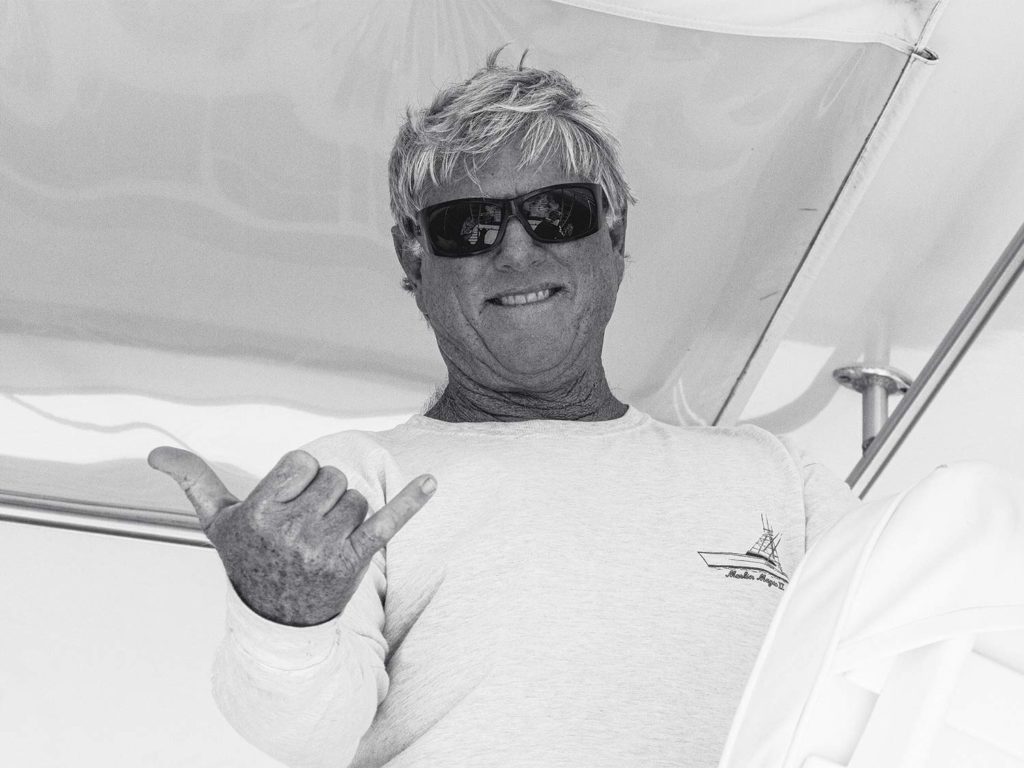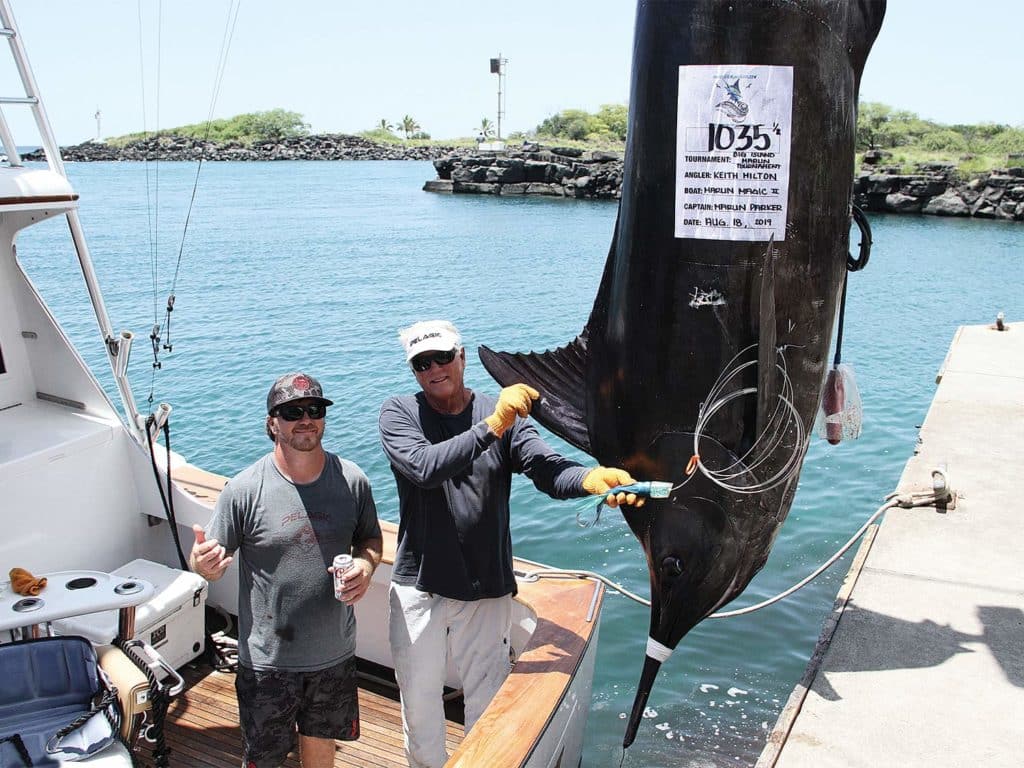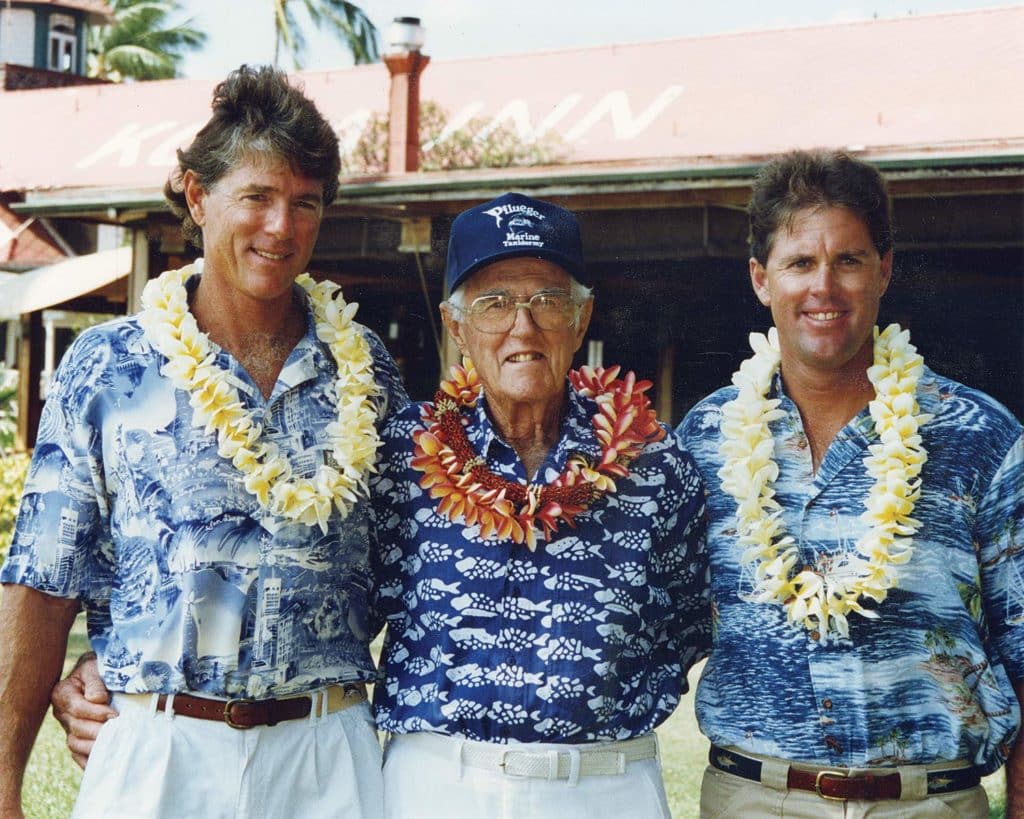
Perhaps more than any before him, Capt. Marlin Parker was destined for a life at the helm. In November 1954, his father, Capt. George Parker, landed a 1,002-pound Pacific blue marlin fishing out of Kona, Hawaii. It was the first blue over 1,000 pounds caught in US waters, smashing the existing all-tackle world record at the time. Marlin was born shortly thereafter, and named accordingly. He continued to fish with his father growing up. Only months after receiving his captain’s license in 1977, he weighed a 1,257-pound blue marlin, which at the time was the largest caught off the Big Island of Hawaii on 80-pound-test tackle. That was just the start of Marlin’s big-fish career.
Q: Your father, George, was one of the pioneers of offshore sport fishing in Kona. How did he get started?
A: My dad started fishing in the 1940s out of Oahu on a 50-foot sampan, when there were mostly commercial fishermen in Hawaii. One time, four guys wanted to charter his boat, Mona H, to check out the Big Island, and they were just getting railed left and right by big fish. That’s what brought Dad to Kona. Back then, the Kona Inn had a bar right on the water, and he and a few other captains figured out that if they caught a marlin, they could unload it at the pier, hang a block and tackle system on a palm tree, and hoist up the fish in front of the bar. People would come around asking questions, and they could generate charters that way.
Q: And he was making his own lures?
A: He and Henry Chee talked about different bevel faces; they had all kinds of ideas. With one of his first ones, my dad cut a bevel in a piece of a chrome towel rack, added a wooden dowel, some lead and some vinyl skirts; that was the lure he caught the 1,002-pound fish on in 1954. Watching him growing up, I wanted to make my own lures, and I caught some pretty big fish on them, so I started making a few for my friends. They’d get broken off on big fish, and I’d say, “Well, the next one’s gonna cost you,” and that’s how I got into the lure business in the late 1970s. Gary Eoff was my insert-maker who cut the abalone shell at the time, and he became my partner in Marlin Magic Lures in 1980.

Q: How many do you produce a year?
A: Probably thousands, just depends on the year. But we don’t market a lure until it’s proven to catch fish. We fish a lot. These days I’m charter fishing about 180 to 200 days a year, plus another few weeks in Mexico; in the past, we’ve fished as much as 300 days. We go through a lot of R&D on the water, and it’s a hard way to make money. There’s a lot of work and not a lot of revenue.
Q: If you had to pick one lure and color, what would it be?
A: The regular Ruckus. That’s the one that caught our last grander, and it’s produced more big fish than you can count. For colors, I like a blue back with a white shell head, although we’ve been using some dichroic glass recently, a blue/green called lava with no eye that works really well. People think it’s the boat or the captain; we pull five lures in the pattern, and one will stand out all month—and then it changes. Blue-and-green will be good for a while, then all black, then maybe it’s pure white. Maybe it’s pink if there are a lot of squid around early in the morning. I know there’s a difference. I’ve been doing it for so long, and I study it every day.
Q: What advice would you give those people who are just starting out lure-fishing for blue marlin?
A: First, I’d say keep it simple. When we won the Bisbee’s in 2004 and 2016, we had five lures behind the boat. Dredges and ballyhoo are fine for sails and small marlin, but you don’t need all that stuff for big fish. A marlin’s brain hasn’t gotten any bigger. Those fish are so curious—if they’re hungry, they’ll eat.

Q: You fought and lost the biggest blue marlin of your career in a fight that lasted 23 hours. What was the story with that one?
A: It was in 1990—the commercial guys longlining between Maui and the Big Island were seeing 150- and 180-pound bigeyes that had been squashed from being swallowed, and something was wrecking their gear. They said that in three weeks, we’d see some giant marlin off Kona. A month later, we were on an overnighter 35 miles south of the harbor with Steve Schumacher, who is an excellent heavy-tackle angler, fishing a couple of live baits off a FAD buoy. Around 4:30 in the afternoon, I saw a shape like a submarine coming for the short bait and thought it was a false killer whale, except it had this fluorescent stripe running down the side. Steve hooked the fish, and we tried every trick in the book during the fight—and I mean everything. We could get it close, but every time we did, the marlin would just squirt away. Steve fought the fish by IGFA rules for 21 hours. At 1:30 the following afternoon, he was mentally and physically exhausted and finally had to give up, so we put my mate, Steve Epstein, in the chair with a ton of drag on the reel. He fought it for 30 minutes, and the fish made a death dive. Steve [Schumacher] got back in the chair, and the fish came up, and then made a second screaming dive around 500 yards straight down and died. We tried to plane it up in a really strong subsurface current, but after gaining line inch by inch for about 60 yards, the mono finally snapped. Five weeks later, after losing two others over 1,000 pounds, I caught a 1,400-pounder, and the 23-hour fish dwarfed them all.
Q: Do you feel that a 2,000-pound marlin is out there, and if so, where?
A: If there is one in the Pacific, it lives either here in Hawaii or in Tahiti. I’ve had 12 trips to Australia to fish for a month or two, and there are plenty of stories there about 2,000-pound blacks. Their biggest ever is Peter B. Wright’s 1,442. Bart [Miller] had one here on an 80 that he called over 2,000 pounds. There have been three battles here in the 20-plus-hour range—I know of another boat that went for 36 hours on one. Those guys were good heavy-tackle fishermen who knew about drag; they fought the fish for the first eight hours with their anglers and the rest in the rod holder and couldn’t turn the marlin. But that’s what keeps us going: the chance to see the fish of a lifetime.







